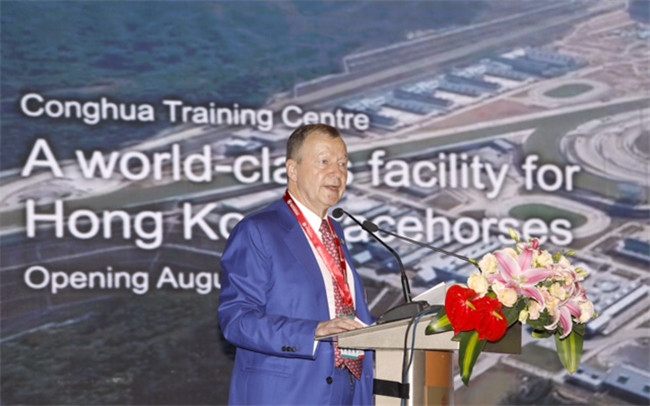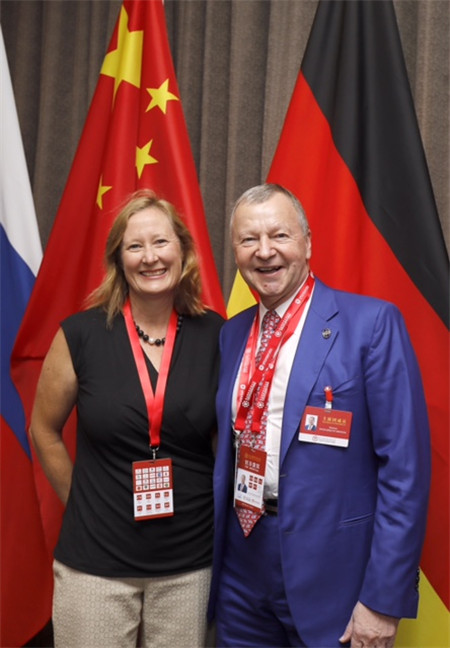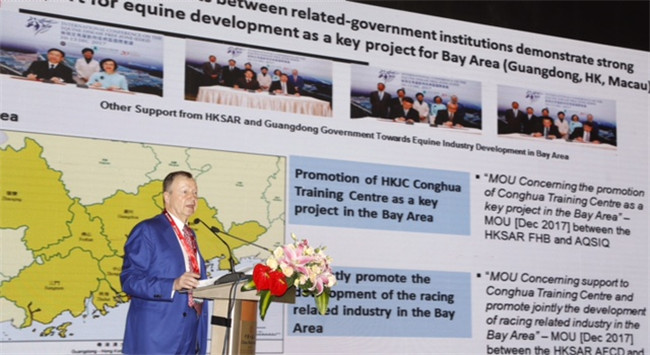Q1. You led a high-level delegation from the HKJC to attend the WEVA Congress in Beijing. May we know why?
Firstly I would like to congratulate the World Equine Veterinary Association (WEVA) and the China Horse Industry Association (CHIA) on the great success of the 15th World Equine Veterinary Association Congress in Beijing – the first time the world’s most authoritative professional equine veterinary conference has been held in the Chinese mainland. It was an honour for The Hong Kong Jockey Club (HKJC) to support this important conference.

Hongkong Jockey Club Chief Executive Officer Mr Winfried Engelbrecht-Bresges says best practices of the Club will be fully applied at its new Conghua Training Centre, located just outside Guangzhou and due to open in August this year
Having been a horse lover for over 30 years, I fully support WEVA’s goal of continuously advancing the health and welfare of horses worldwide. This is especially important given that horses are the foundation of the global equine industry, which can bring significant economic and social benefits to our societies, including in the Chinese mainland. This is why the HKJC supports equine sports and equine veterinary care in the Chinese mainland.
It was to show our support for the Congress, and to equine sports and equine veterinary care in the Chinese mainland, that the HKJC sent a high-level delegation. In addition to myself, this comprised five senior members of the Club’s management team, who gave presentations on integrity in racing, veterinary regulation, racetrack design and drug testing, and also chaired a session on equine health. The HKJC was also pleased to help out with the practicalities of the Congress, including programme design and assisting with the invitation of speakers.
Q2. What is the significance of the WEVA Congress for China?
The Congress not only provided a platform for professional exchanges between veterinarians from overseas and China, it was particularly helpful in raising public awareness in China of the importance of horse health and welfare. It also raised the profile of equine veterinarians in the country.
The work of the CHIA in promoting the development of China’s horse industry in a healthy and orderly way is particularly commendable. By co-hosting this Congress, the CHIA has taken a major step in elevating the position of China in the veterinary world. Indeed, this has been a very fruitful Congress and I wish CHIA every success in their journey to develop China’s horse industry.
Q3. What were the key messages in the HKJC’s presentations that you wanted like to bring to Congress attendees?
Given that this Congress was in China, and that China is on a journey to developing its own modern equine industry, I think the HKJC made some highly relevant points during the Congress.
We outlined the importance of horse welfare and how this is vital to the success of the HKJC’s racing model in terms of quality, consistency and integrity. We also highlighted what is necessary to further enhance horse welfare, especially in China.
We explained that the Club is widely recognised as one of the leading racing jurisdictions in the world, admired for the competitiveness of its racing and the world- class quality of its horses, trainers, jockeys, and management.
Fundamental to this success are the HKJC’s capabilities and best practice approach to racing management. This includes the recruitment and training of top professionals, investment in state-of-the-art racecourse facilities, a strong commitment to horse welfare, and the rigorous monitoring of races and of the training of racehorses to ensure complete integrity.
All of this has enabled the HKJC to create a world-class racing brand for Hong Kong which is the envy of the world. So, despite having only 0.7% of world’s active thoroughbred horse population and no breeding industry, Hong Kong has 6.5% of world’s top racehorses. And despite having only 0.8 % of the world’s races, 9 % of the world’s top 100 races are run in Hong Kong.
Q4. Could you share with us more about the HKJC’s highly regarded model of quality, consistency and integrity?
Our world-class racing is renowned for its uncompromising integrity, and it is this which underpins our reputation for quality and consistency.
Each race meeting is supervised by a panel of seven Racing Stewards chaired by a Club Steward. The panel closely monitors the running of each race for any possible breach of the Rules of Racing, aided by state-of-the-art technology.
Our Racing Laboratory conducts pre-race, post-race as well as in-training testing of blood and urine samples to check for the use of banned substances in horses or jockeys. It is internationally recognised for the quality of its work and has never reported a "false positive" finding since it was established in 1970.
In fact Hong Kong's post-race positive results are seven to eight times lower than the world average, which shows how Hong Kong's fair and just approach to racing acts as a deterrent to malpractice.
The laboratory is one of only five Approved Laboratories appointed by the Federation Equestre international (FEI) and five Reference Laboratories for the International Federation of Horseracing Authorities (IFHA).
Also playing an important role is the Club's Security & Integrity Department, which provides an additional layer of monitoring.

Hongkong Jockey Club Chief Executive Officer Mr Winfried Engelbrecht-Bresges meets with Dr Kate Savage, President of WEVA at the WEVA Congress.
Q5. Could you give us just one example of the HKJC’s renowned operations excellence?
We are proud to have well-established, platinum standard, veterinary policies, practices and personnel. This includes an equine hospital, equipped with such state-of-the art facilities as an MRI system, computerized radiography for high-definition x-rays, and a gamma camera to facilitate bone scans.
The veterinary team itself is divided into two functions. A clinical team, which provides veterinary care, including during race meetings; and a regulatory team, which determines the suitability of each horse to race and supports Racing Stewards in maintaining the integrity of racing. All our veterinarians are world-class professionals.
Q.6 What kind of support has the HKJC been providing to equine sports and horse welfare in China and in what ways can the HKJC help develop the equine industry in China?
Over the years, the HKJC has provided significant support for the development of equine sports and equine veterinary care in the Chinese mainland.
With our world-class racing and management expertise we were appointed to construct and help manage the venues for the equestrian events of the Beijing 2008 Olympic and Paralympic Games, which were held in Hong Kong.
In 2015, the HKJC signed an MOU with the CHIA to provide technical support, including advice on racing integrity and standards, effective doping control and modernisation of the China Stud Book, as well as assisting in ongoing horse care and veterinary training.
Perhaps most significantly, the HKJC’s Conghua Training Centre in Guangdong Province, scheduled to open in August 2018, will see world-class standards of equine training and veterinary care. A key component of this is its biosecurity zone – the only internationally-recognised Equine Disease Free Zone in the Chinese mainland. Its operation was reinforced by the signing of MOUs between Chinese mainland and Hong Kong government authorities last December.
Looking ahead I believe that the HKJC, given its position as world-wide recognised centre of excellence in equestrian sports and racing, can utilise the Conghua Training Centre and the Equine Disease Free Zone to support the development of the equine industry in China. In particular it can help establish the Bay Area (covering 11 cities in Guangdong including Hong Kong) as a global centre of excellence for high-performing horses.
This will involve all aspects of the equine industry’s value chain, ranging from competitions, horse welfare, talent training and development within the areas of stable management, veterinary and farrier care, to associated industries such as horse movement services, feed, drugs, equipment, breeding, horse sales and auctions.

Hongkong Jockey Club Chief Executive Mr Winfried Engelbrecht-Bresges explains how the Club can contribute to the development of the ‘equine value chain’ in the Chinese mainland, and the establishment of the Greater Bay Area as a world-wide centre of excellence for high-performing horses.
Q7. Is there anything the equine industry of China can learn from the Club to help it internationalise itself and strive for best practices?
I am very impressed by the contribution and dedication of veterinarians in the Chinese mainland. They are thoroughly deserving of recognition and support as a profession.
However I do think there are areas where more progress is needed. There need to be more qualified veterinary surgeons to provide proper care for horses. Clinical facilities need to be adequately equipped to allow veterinarians to perform surgical and therapeutic practice to a world-class standard. Drugs and medication need to be readily available to treat equestrian horses, especially high-performance horses. Lastly supporting staff, including farriers, need to be trained to a high standard, particularly those looking after high-performance horses.
Q8. Could you give an update on the latest development of the Conghua Training Centre (CTC) in Guangdong? How significant is this establishment for China?
The Conghua Training Centre (CTC) is a legacy of the 2010 Asian Games, which were held in Guangzhou. Having supported the equestrian events at Conghua, the HKJC, with the support of Chinese mainland authorities, determined it would be the ideal venue to construct its new horse training center.
We have invested some four billion RMB in constructing the CTC, with a special focus on horse welfare. Work is almost complete and the new centre is due to open in August this year.
The CTC is significant for China in several ways. Firstly it will be the first world-class thoroughbred training centre in the Chinese mainland, and also the first world-class veterinary clinic, staffed by internationally-qualified talent. Secondly it is supported by an Equine Disease Free Zone – the first and only one in the Chinese mainland – which facilitates the movement of horses between Conghua, Hong Kong and overseas without them having to go through quarantine checks. As I have mentioned, all of this this puts China in an excellent position to develop its equine industry, particularly in the Bay Area.
